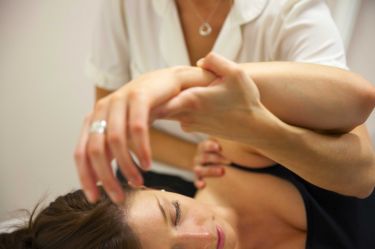What, who and how do osteopaths treat?
Osteopaths specialise in the diagnosis, rehabilitation, management and prevention of musculoskeletal (Muscles and Joints) disorders. Based on the principle that the well-being of an individual depends on the skeleton, muscles, nerves, ligaments and connective tissues functioning smoothly together. Osteopath’s patients include people of every age and occupation, including pregnant women, children and sports people.
Patients seek treatment for a wide variety of conditions, including pain, stiffness and disability, poor posture, repetitive strain at work, the pain of arthritis and minor sports injuries;
- Back and neck pain
- Sciatic pain
- Neck / Shoulder tension
- Cervicogenic (neck related) Headaches
- Shoulder pain
- Sports Injuries
- Osteoarthritis pain
- Hip and knee pain
- Repetitive Strain Injuries (RSI)
- Tendonitis
- Tennis and Golfers’ Elbow
- Ankle and foot Sprains
- Jaw Pain or related problems
- Postural Strain
- Coccyx pain
Diagnosis involves a combination of osteopathic and conventional medical diagnostic techniques. This approach emphasises the integration of the musculoskeletal system with other body systems and the influence that impaired function of each has on the other. It also seeks to empower and educate patients in assisting their recovery to good health. Osteopaths work alongside GPs, Consultants and other healthcare professionals.
Treatment is hands-on and includes a variety of highly skilled techniques ranging from very specific manipulative procedures to mobilise joints, to more gentle rhythmic articulatory movements to encourage further mobility, stretching and massage, to relieve muscle shortening and tension.
Your osteopath will always explain what they are doing and will always ask your permission (consent). Please ask questions at any time, especially if you are unsure what you have been told or if you have any concerns. Treatment is generally, entirely comfortable and relaxing, occasionally there might be some minor discomfort, for example relating to a stretch and often this is reassuring that treatment is well focused.
Self-help measures and advice on lifestyle, ergonomics at home and work and exercises may be offered to assist your recovery and prevent recurrence.
Ongoing care. Because of the physical nature of the treatment, it is not unusual to sometimes feel sore or at least no better in the first 24-48 hours after treatment. We will explain any likely reactions that you could expect. If you have any concerns, please contact us for further advice. Of course it may require more than one visit before your problem is resolved, especially if you have had it for a while. We will of course review your progress at each subsequent visit and adjust your treatment plan accordingly.
The Profession of Osteopathy
Osteopathy is a statutory regulated and title protected healthcare. All osteopaths in the UK are regulated by the General Osteopathic Council (GOsC). The title 'Osteopath' is protected by law. It is against the law for anyone to call themselves an Osteopath unless they are registered with the GOsC, which sets and promotes high standards of competency, conduct and safety. Osteopaths are required to renew their registration each year. As part of this process, the GOsC checks that osteopaths have current professional indemnity insurance, remain in good health and of good character, and have met mandatory continuing professional development requirements.
Standards of training & practice
All Osteopaths practising in the UK have completed rigorous training. Students of Osteopathy follow a four or five-year degree course, during which they study anatomy, physiology, pathology, pharmacology, nutrition and biomechanics. In addition they undergo a minimum of 1,000 hours of clinical training.
The profession attracts almost equal numbers of male and female practitioners, and some have already qualified in another healthcare practice such as medicine, Nursing or Physiotherapy.
Most Osteopaths are self-employed and work in the private sector, although some are working in multi-disciplinary environments within the NHS and in occupational healthcare in public bodies and private companies.
Continuing professional development
Osteopaths are required to keep their skills and knowledge up-to-date with a lifelong learning programme of continuing professional development (CPD). This can include lectures, seminars, courses, practical sessions, individual study or other activities that can advance an osteopath’s professional development.
Recommendations for Osteopathy
A Medical Research Council trial comparing treatment options for lower back pain found that spinal manipulation, added to GP care, is clinically effective and the most cost-efficient option for patients.
The Department of Health has published guidelines which advocate the establishment of multidisciplinary clinical assessment services and recognised that Musculoskeletal Disorders can often be resolved quickly and effectively by treatments such as osteopathy.
The National Institute for Health and Clinical Excellence (NICE) has published guidance on the treatment of non-specific low back pain, should include manual therapy, as practised by Osteopaths. This includes spinal manipulation, mobilisation and massage, for patients who “have been in pain for longer than six weeks but less than one year, where pain may be linked to structures in the back such as joints, muscles and ligaments”.
The General Medical Council has published guidelines for the referral of patients to an Osteopath. This guidance confirms that GPs can refer patients to Osteopaths as statutorily regulated health professionals.

